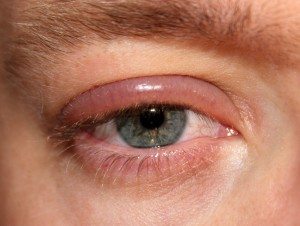 Blepharitis is a common condition that causes inflammation of the eyelids. The condition can be difficult to manage because it tends to recur.
Blepharitis is a common condition that causes inflammation of the eyelids. The condition can be difficult to manage because it tends to recur.
Blepharitis occurs in two forms:
- Anterior blepharitis affects the outside front of the eyelid, where the eyelashes are attached. The two most common causes of anterior blepharitis are bacteria (Staphylococcus) and seborrhea.
- Posterior blepharitis affects the inner eyelid (the moist part that makes contact with the eye) and is caused by problems with the oil (meibomian) glands in this part of the eyelid. Two skin disorders can cause this form of blepharitis: acne rosaccea, which leads to red and inflammed skin and seborrhea.
Symptoms of either form of blepharitis include a foreign body or burning sensation, excessive tearing, itching, sensitivity to light (photophobia), red and swollen eyelids, redness of the eye, blurred vision, frothy tears, dry eye, or crusting of the eyelashes on awakening.
Complications from blepharitis include:
- Stye: An infection of one of the enzyme secreting glands in the eyelid.
- Chalazion: An inflammation of one of the oil glands in the eyelid.
- Problems with the tear film: Abnormal or decreased oil secretions that are part of the tear film can result in excess tearing or dry eye. Because tears are necessary to keep the cornea healthy, tear film problems can make people more at risk for corneal infections.
Treatment for both forms of blepharitis involves keeping the lids clean and free of crusts.
- Warm compresses should be applied to the lid twice a day to loosen the crusts. In addition, patients with posterior blepharitis will need to massage their eyelids to clean the oil accumulated in the glands
- Lid scrub (a light scrubbing of the eyelids) with a cotton swab and a mixture of water and baby shampoo.
- Artifical tears have also proven beneficial when used three or four times a day.
Because blepharitis rarely goes away completely, most patients must maintain an eyelid hygiene routine for life. If the blepharitis is severe, antibiotics or steroid eye drops may be prescribed.
But now there is an exciting in-office treatment, BlephEx®, which allows the doctor to treat blepharitis by eliminating the biofilm and bacterial toxins along the lid margins and lashes that cause inflammatory lid disease and dry eye.